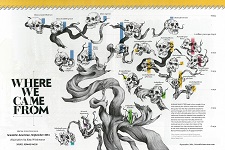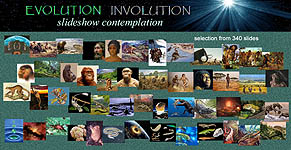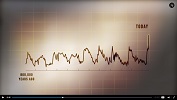Note: My Anthropic Trilogy web-book, evolving since 1997, is a chronicle of my passing all considered opinion through the lens of my Nirvikalpa Samadhi with both an open-mind and healthy skepticism.
Anthropic Trilogy Graphical Sitemap
BOOK 3 ― EVOLUTION INVOLUTION
INTRODUCTION
The Evolution-Involution Slideshow
For Study and Contemplation of Our Human Phylogeny - to The Big Bang and Beyond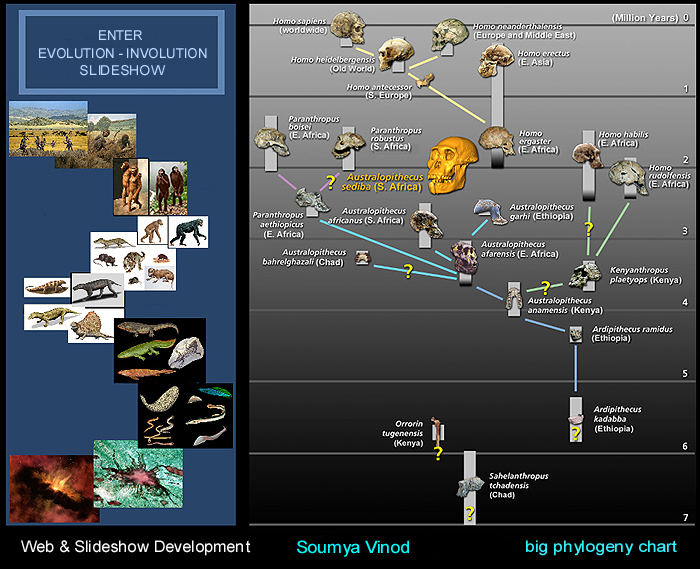 All Images © Individual Artists
Alternative Version of Hominin Phylogeny #1 Chart
Alternative Version of Hominin Phylogeny #2 Chart
Alternative Version of Hominin Phylogeny #3 Chart
All Images © Individual Artists
Alternative Version of Hominin Phylogeny #1 Chart
Alternative Version of Hominin Phylogeny #2 Chart
Alternative Version of Hominin Phylogeny #3 ChartIllustrated Cladogram of Hominoid/Hominin Evolution Source: Special Evolution Issue - Scientific American, September 2014
Presenting the Greatest Story of Reality Ever Told anthropic bio-evolution and involution through cosmic consciousness - is science closing in?
Evolution-Involution Slideshow A pictorial presentation of our past lives with glimpses of a few of the concurrent perils and mass extinctions we had to survive at various stages of our evolution on Earth. The story continues for even more billions of years before Earth was formed as prebiotic substance slowly formed from elements arising from the Big Bang 13.7 billion years ago. The slideshow is a HTML5 Slider production with full-sized images and is designed so that a viewer can first pause each image with captions to digest the information- then run the slideshow as a seamless involution (with captions turned off) for a contemplative experience. Optimum Slideshow experience via latest version of Google Chrome Browser
Evolution-Involution Gallery Google Gallery version of slideshow with captions.
Image Map preview from 340 slides in Evolution Involution Slideshow Contemplating the eternal mystery of how and why life evolved from a Big Bang to us.Additional resources for further reading at phylogeny slideshow references
Because the story is largely based on interpretation of evidence from ongoing discoveries in anthropology, paleontology, gene sequencing and cosmology it is in a continual state of evolution and controversy. Uncertainties do not end there because the philosophy of science is just starting to take up the challenge of integrating quantum theory and consciousness that effect our view of the observable material universe and a reality beyond the Big Bang.
The infinitesimal steps we have taken to begin to understand the story of evolution is an epic so vastly more complex than the Biblical story of Genesis, I needed images to capture our spiritual imagination at the level of Michelangelo's most famous work of the Creation of Man along with the entire body of renaissance art that effectively brought the dramatic stories of the Bible into belief of their literal reality. This process continues in today's multi-media environment and sustains belief in Adam and Eve over evolution by the majority of Americans.
Details from a mural by Viktor Deak and Reuben Negron for the exhibition - Lucy's Legacy: The Hidden Treasures of Ethiopia, at the Houston Museum Of Natural Science, Houston Texas. Australopithicus afarensis ("Lucy") is depicted holding her baby in center of lower panel. (This detail is presented as a mirror image of the original, consistent with the involution perspective of our slideshow.)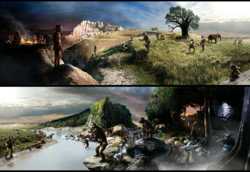
closeup mural details and here photos by Trish Mayo Read more
I found such contemporary classical masterworks in the superbly realistic work of Karen Carr- some of which are even on a scale of the ceiling of the Sistine Chapel- rendered in murals installed on the walls at the Royal Teyrrell museum in Toronto, Chicago''s Field Museum and the New Mexico Field Museum. On an equally grand scale are the masterful murals painted at the Smithsonian National Musum of Natural History by John Gurche and Jay H. Matternes. Gurche is also one of the formost 3D reconstructionists of extinct hominids along with Viktor Deak; and Elisabeth Daynès whose work bring to life iconic stages in our human phylogeny in museum exhibits worldwide. Jay Matternes's illustration of Australopithecus ramidus, popularly known as "Ardi", is probably the most appropriated of all paleo art on the Internet, primarily in articles about human origins. A series of inspiring murals on a similar grand scale has recently been created by William Stout for the San Diego Natural History Museum.
These featured artists along with others whose work help power our imagination in contemplating the grandeur of our true origins, have been appropriated here (with the hope I can obtain their official permission) for our purpose - to provide a sensory experience that has the persuasive impact to advance the evolutionary paradigm comparable to that which all the religious works of art had in advancing belief in the reality of their various orthodoxies.
Artists Please Note: Some of the full-sized images that will be viewable in the Flash slideshow have watermarks removed. This is because any text on the images is a profound distraction for the contemplative experience. Explicit attribution is provided for each image with an active link in the captioning, in their listing in this page and in the Phylogeny Slideshow References page. Every effort has been made to mitigate primary system downloading. All rights are reserved by individual artists and I am in the process of asking artists for permission to use their images for non-profit, educational purposes- to advance the Evolution-Creation Paradigm.
I've drawn on the talent of other exceptional contempory artists who have particular passion for paleo art. In alphabetical order: Mauricio Antón; Cristóbal Aparicio Barragán; Daniel D. Brown, Ph.D.; Carl Buell; Giovanni Caselli; Julius T. Csotonyi; Stanton F. Fink; Jon Hughes & Russ Gooday; Adrie and Alfons Kennis; Mark A. Klingler; Raúl Martin John Sibbick; Nobu Tamura; and Keiji Terakoshi.
Equally dramatic are the works of illustrators of cosmological scenes such as Lynette Cook of Gemini Observatory and of subatomic stuctures like Keith Beardmore and of space art like Don Davis and Thomas Peters.
I also feature the legacy of two paleo artist now deceased. The 19th century illustrations of Ernst Haekel (1834-1919) published in his 100 Plates of KUNSTFORMEN DER NATUR (Artforms of Nature) in 1904 and the dramatic fineart paintings by Czechoslovakian paleo artist Zdenĕk Burian (1905-1981). I wanted to include a work by America's first fine-paleoartist, Charles R. Knight. Although he focused on dinosaurs, his most famous painting (La Brea Tarpits) depicts megafauna that prehistoric humans in America had to contend with. All three created images that are enduring treasures.
In the captions- some of the illustrations are simply attributed to the website where they were found because so far I have been unable to identify the artist due to the unfortunate regularity for websites to appropriate graphics without even the courtesy of attribution.
The hope is that the contemplative experience can provide a unique past lives experience- an involutionary imagining of the reality of the incomparable magnificences of the process of our origins- from prebiotic substances coalescing from the Big Bang to the excruciatingly slow evolution of billion of years to our first multicellular organisms. At every stage our ancestors were in constant competition with ever-present fearsome contemporary predators yet continually evolving as pre chordata and finally the relentless progress to the many variations of early primates. Evolution! ...the momentous process that- in the face of cataclysms in Earth's upheavals and mass extinctions- against all odds has allowed our species to survive the grim statistic in which more than 99 percent of all species that have ever lived became extinct. Yet as with each kind that has had its time to flourish- our destiny is still uncertain. We can only hope that the singularity that has fine-tuned our universe with constants that allowed for life to arise has gifted us with the will to finally manage the unsustainable impact our species has fostered on our planet over the past two hundred years to avoid the sixth mass extinction that may already have begun. (It is estimated that since the Phanerozoic 500 Mya, fossil remains of less than 7% of species that existed during any given period have been recovered. Given the reality that less than five percent of extant insects have been identified (much less described) and an even smaller percentage of micro-animalcules- that estimate for known extinct organisms may be wildly optimistic.)
Artists Please Note: Some of the full-sized images that will be viewable in the Flash slideshow have watermarks removed. This is because any text on the images is a profound distraction for the contemplative experience. Explicit attribution is provided for each image with an active link in the captioning, in their listing in this page and in the Phylogeny Slideshow References page. Every effort has been made to mitigate primary system downloading. All rights are reserved by individual artists and I am in the process of asking artists for permission to use their images for non-profit, educational purposes- to advance the Evolution-Creation Paradigm.
"Ten billion bacteria live in a gram of ordinary soil...they represent thousands of species, almost none of which are known to science." [O.E. Wilson, Naturalist, 1984]
The Cosmos Wakes Up Zen Buddhist teacher David Loy asks: "Is evolution the universe waking up to itself?" It was a 14-billion year journey from simple hydrogen to Mahatma Gandhi. Religions tend to deny or ignore evolution, but what happens if instead they embrace it and make it central to their message? For Buddhists, the relevant question is what the teachings on impermanence and insubstantiality imply about the Big Bang and evolutionary development.
The project itself is an amateur effort to present an intimate synopsis of our phylogeny and origins. No image represents our exact ancestor but is only an approximation of what we resembled before evolving towards our future. Some images simply picture concurrent cousins or predators or cataclysmic events in our environment that we at the time survived.
This slideshow is planned as a lifelong work in progress with its anatomy and captioning in stages of continual updating.
There is an obvious ontological implication in how I present the Evolution-Involution Slideshow that suggests that our consensus reality is an ongoing evolution of scientific and metaphysical knowledge that tends towards a future synthesis. I explore the present state of this effort at Theosophical Synthesis encouraged that the process seems to be outpacing our biological evolution.
 Cosmic Phoenix - infinite universes evolving - involving
Cosmic Phoenix - infinite universes evolving - involvingCredit: Exper Giovanni Rubaltelli
Big Bang Ghost? Science & Tech, 2012 Does this picture show the 'ghost' of a universe that existed before the Big Bang? Renowned scientist Professor Roger Penrose from Oxford University has spotted evidence that a universe may have existed before the Big Bang. Penrose says concentric circles discovered in the background microwaves of the universe provides evidence of events that took place before the universe came into being. This supports a cosmological theory of a cyclic universe- a feature in the creation cosmography of the Vedanta tradition.
Update 05 03 10: Halfway through the process of assembling graphics to illustrate the phylogeny/contemplation slide show I stumbled upon the book by Professor Richard Dawkins entitled The Ancestor's Tale. See Google Books
Publisher's Review: The Ancestor's Tale is a pilgrimage: a journey of four billion years. We, modern human beings, are the pilgrims, and we are travelling back in time to seek out our ancestors. Simult neously every other living creature - animal, plant, fungus, bacterium - is setting off on its own journey with the same mission. As we travel down the path of time, we meet up with other bands of pilgrims with whom we share a common ancestor.
Onwards we go, squeezing precariously through mass extinctions, meeting increasingly distant common ancestors. Eventually we pass that fundamental turning point for life on Earth, the combining of a single-celled protozoan-to-be with a bacterium to form a cell with a nucleus. Once we have done so, all living things take the final stretch of the pilgrimage together to the origin of life.
This is the majestic narrative that holds together this remarkable book. Yet the chronicle of the journey is itself an envelope for the collection of tales told by the pilgrims. These tales cover the processes involved in the unfolding of life on Earth. Enormously rich and diverse, they incorporate the results of recent research which uses the study of DNA to give some startling insights into evolutionary history. The fundamental unifying principle of evolution underlies every tale, and binds them together into this unique history - our history, and that of all living things.
Central to this book is the tracing of our ancestors and our connections with other living creatures. The Ancestor's Tale shows us how remarkable we are, how astonishing our history, and how intimate our relationship with the rest of the living world.
Professor Richard Dawkins is a world-renowned evolutionary biologist and author. He is a Fellow of the Royal Society and holds the Charles Simonyi Chair of Public Understanding of Science at Oxford University. His first book, The Selfish Gene (1976), was an instant international bestseller, and has become an established classic work of modern evolutionary biology. The Blind Watchmaker (1986), too has become world-famous. His other works for the general public, every one highly successful, include River Out of Eden (1995), Climbing Mount Improbable (1996) and Unweaving the Rainbow (1998). A collection of his writings. A Devil's Chaplain, was published by Weidenfeld & Nicolson in February 2003.
Note: In the following review of Dawkins' book, it should be noted that in the debate between Darwinian evolution and creationism, Dawkins is famously known as Atheism's rottweiler and his primary antagonist, Professor Behe, argues as a trained scientist rather than from a religious perspective.
A Review of The Ancestor's Tale (2004): A Pilgrimage to the Dawn of Evolution by Richard Dawkins by Michael J. Behe (2005) Michael J. Behe is a Professor of Biological Sciences at Lehigh University in Bethlehem, Pennsylvania. Behe's first criticism in his review is with Dawkins' running the course of evolution backwards (as in the evo/invo slideshow). He continues with: "The second major defect of the book is that, other than a dust jacket photo of the author, it has no high quality, color photographs. Even the driest biology textbook these days includes plenty of spectacular photos and illustrations, which often can entice reluctant students into reading the text. Yet The Ancestor's Tale grudges only the occasional, tiny, black and white photo or graph to accompany the discussion. This really is unforgivable, because it works against the whole purpose of Dawkins' book - to evoke wonder at life. One figure legend touting "rustling rivers of green" refers to a black and white photo of leaf cutter ants. It's hard to even puzzle out what's going on in some pictures, such as those of the upside-down catfish (looked at from ny angle) or Heron Island (what is that thing? a cell? a kidney?). The poor photos make it impossible to share Dawkins' rapture over Venus's girdle or the leafy sea dragon - they're splotches of ink. Although Dawkins' prose beats textbook writing by a mile, the texts win hands down on illustrations. All in all, then, I'd recommend a high school biology textbook over The Ancestor's Tale, because great pictures of life can more than compensate for stodgy prose."
For a well-illustrated college-level introduction to biology text, see: Biology: The Dynamic Science Volume 2 by Peter J. Russell, et al, 20011
I hesitate to make any claim of synchronicity other than both Dawkins' book and the phylogeny/involution slide show uniquely trace our phylogeny backwards in time rather than the alternative convention of presenting its evolution from a variety of origins of life. Due to the depth and breadth of Professor Dawkins' erudite scientific knowledge there is no comparison between his profoundly epic tale and my superficial production yet I suspect that our disparate levels - one profound and logical - the other simplistic and extending into metaphysics - can work synergistically to expand our conscious re-experiencing of "evolution/creation" than either resource provides alone.
My first priority has been to complete the first draft of the Evolution-Involution Slideshow as a Flash presentation and this was completed (11 09 10). Professor Dawkins book will certainly be a major reference for refining and updating all the ordering and captioning.
Additional resources for further reading at phylogeny slideshow references
Decoding the Weather Machine Aired on Earth Day - April 18, 20018 Presents hard evidence for the greatest threat already underway to all life on planet Earth - caused by human industry. Disastrous hurricanes. Widespread droughts and wildfires. Withering heat. Extreme rainfall. It is hard not to conclude that something’s up with the weather, and many scientists agree. It’s the result of the weather machine itself—our climate—changing, becoming hotter and more erratic. In this two-hour documentary, NOVA will cut through the confusion around climate change. Why do scientists overwhelmingly agree that our climate is changing, and that human activity is causing it? How and when will it affect us through the weather we experience? And what will it take to bend the trajectory of planetary warming toward more benign outcomes? Join scientists around the world on a quest to better understand the workings of the weather and climate machine we call Earth, and discover how we can be resilient—even thrive—in the face of enormous change.
 Click for full-sized poster
Click for full-sized poster
Credit:
Tree of Life Biology Poster
Update 02 15 2012: Evolution - 1 Minute Slideshow An animated gif featuring graphic hyperlinks in the evolution of our human phylogeny from the origin of life on Earth.
Timeline of Evolution Major episodes from life's origin 3.8 billion years ago.
- 1. Archaea and Bacteria (Archaean and earlier 3.8 bya)
- 2. Eukaryotes (Proterozoic 2.5 bya)
- 3. tunicate larvae (Ediacaran 555 mya - chordata)
- 4. lancelet (Cambrian 553 mya - chordata invertebrate)
- 5. pikaia (Precambrian 550 mya - hemichordate invertebrate)
- 6. conodonts (Ordovician 450 mya - euchordata)
I've ordered conodonts preceeding haikouichthys as it seems they would resemble a missing link in the fossil record between pikaia and fish-like organisms.
- 7. haikouichthys (Late Cambrian 520 mya - vertebrate)
- 8. Cephalaspis (Devonian 400 mya - vertebrate)
- 9. Tetrapod Evolution top: pederpes (Early Carboniferous 350 mya - early tetrapod); middle: hynerpeton (Late Devonian 360 mya - basal tetrapod); bottom: panerichthys (Devonian 397 mya - pre-tetrapod)
- 10. early amphibian (Carboniferous 340 mya - true amphibian) Sterkfontein Exhibition
- 11. Hylonomus lyelli (Carboniferous 300 mya - early reptile) Artwork: John Sibbick http://www.johnsibbick.com/
- 12. varanops (Early Permian 270 mya - varanopid synapsid)
- 13. Dvinia prima (Later Permian 256 mya - Therapsida)
- 14. Hadrocodium wui (Jurassic 200 mya- proto mammal - lived almost 200 million years ago and is one of the closest known relatives to living mammals. It's ancestors survived Triassic/Jurassic extinction event
- 15. Carpolestes simpsoni (late Paleocene 58 mya - primitive primate)
- 16. tarsierfoss (40 mya - primate)
- 17. procounsul (Miocene 23 mya - primate)
- 18. chimpanzee (Middle Pleistocene 8 mya - great apes)
 19. Australopithecus afarensis (3.9 mya - Homo lineage?)
19. Australopithecus afarensis (3.9 mya - Homo lineage?)
20. Image in Slideshow: left: Homo heidelbergensis (.6 mya) middle: Homo ergaster (erectus in Africa) (1.6 mya) right: Australopithecus sediba (1.98 mya - Homo lineage?)
21. Homo sapien (200 kya - modern human)
CONTENT/SITEMAP
Book 3 - Evolution Involution
Evolution-Involution Slideshow Introduction to a pictorial slide show for contemplating the past lives in our hominid phylogeny back to the Big Bang and beyond- with glimpses of some of the concurrent perils and mass extinctions we had to survive at various stages of our evolution.
Big Bang Involution Contemplation Original presentation of Evolution-Involution as album of smallscale-only images with captions with optional slideshow.
Climate Change and the Population Bomb The current maturation of the existential threat to all life on Earth by man-caused climate change and overpopulation is a grim reality that present and future generations will increasingly suffer. I'm presenting a list of resources that helped me understand the inevitability of this debilitating evolutionary process. Even in the unlikely event of a spontaneous global awakening arising in the next few years to try to stop the effects - the inertia of Earth is like the Titanic trying to steer clear of the iceberg.
Cretaceous Extinction Slideshow illustrating progressive stages of recovery of a single landscape within 50 years of the Chicxulub meteor impact.
Evolution-Involution Slideshow References Resources for study of the Evolution-Involution Slideshow.
Journey of Man We examine some controversies in the story told by a leading population geneticist about humankind's history over the last 50 thousand years by tracing markers on the Y-chromosomes of extant populations. PBS Documentary, 2003, hosted by Spencer Wells, director of the Genographic Project from National Geographic.
Genographic Image Map Genographic map presenting migration patterns of the African diaspora of prehistoric Homo sapiens sapiens (behaviorally modern humans) starting 50 thousand years ago, with photo albums of modern descendants of the earliest populations.
Human Family Tree National Geographic DVD documents the results of sampling - on a single day on a single street, in a racially diverse neighborhood in Queens, NY - the DNA of just a couple of hundred random people to create a live, dynamic genographic map of their ancestry back to their shared African origins. Excerpts highlight the immediate plight of the Hadzabe - likely descendants of the prehistoric population who actually left Africa and are ancestors of every human living on the planet today.
Denisovan Radiation Exploring the possibility that Luzia, (name of the 11 KYO fossil remains of a female Homo sapiens, one of a group with anomalous cranial features found in the Lagoa Santa region in Brazil) may represent the first amerindians - neolithic austro-melanesians whose paleolithic ancestors interbred with Denisovan hominins 50 KYO.
An Exploration of Hominoid Radiation In the Miocene (23-5.3 Ma) a most dynamic epoch both in terms of geological and climatic transformation and that of the scale and scope of our hominoid evolution and dispersal. Aside the range of geophysical interpretation as to how and when Africa connected to Eurasia and how the Tethys Sea was configured - major phylogenic uncertainties arise over which species may be in our Hominin ancestral lineage and whether the transformation from hominoid to hominid occurred in Asia, Europe or Africa.
Miocene Hominoid Radiation Map An interactive map with icons showing location of 27 hominoid species that link to their descriptions and more references.
Big Bang Involution Exploring the implications of Big Bang and biological evolutionary theory and potential for a slide show to provide a vizualization to reinforce the metaphysical contemplation of their reality.
Birth of Religion 11,600 years ago, at Göbekli Tepe, hunter-gatherer's urge to worship and build monumental stone temples gave birth to organized religion and likely triggered the Neolithic Revolution - the spark that led to argriculture, plant and animal domestication, permanent settlements and the catastrophe of civilization.
Theosophical Synthesis Presenting resources to explore issues in the tension between science/spirituality and evolution/creation and to examine possibilities for finding common ground and synthesis.
Anthropic Synchronicity Examining Anthropic Synchronicity- as a phylogeny of a living universal matrix - a Meta-Gaia - its myriad features each an essential element in the cosmogenic function of an evolutionary continuum that gave birth to a lifeform with the level of intelligence we humans are imbued with. Have I been led intuitively to this ultimate realization of what my acronym Maya- Gaia infers...that Maya refers to the totality of the perceived and unperceivable universe as imagined by our consciousness and that Gaia is the immanent manifestation of that transcendent body?
Big Bang Inflation A diagram of the history of the universe. Once upon a timeless, most cosmologists believe, all that is our universe was incredibly small and dense. Neither space nor time as we know then existed. Nothing is known of this earliest instant. Scientists use the term big bang to describe this moment of creation. Somehow the universe - all matter, energy, space, and time - exploded from the original singularity.
Ediacaran Index Pictorial index to species of Precambrium Ediacaran lifeforms illustrated in the Evolution-Involution Slideshow.
Legend 1 for image: Rise of Mammals Paleocene Eocene Thermal Maximum.
mammals_rise1_legend.html
Legend 2 for image: Rise of Mammals Paleocene Eocene Thermal Maximum.
mammals_rise2_legend.html
MAYA-GAIA INTRODUCTION & SITEMAP
Anthropic Trilogy Web-Books

